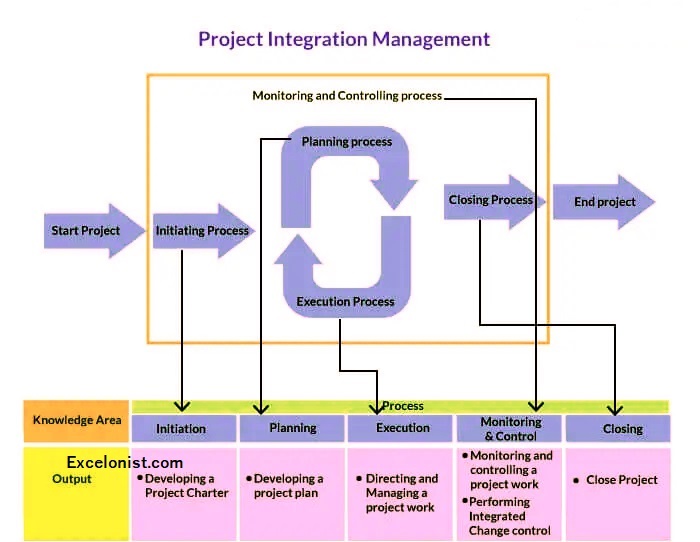What is Project Integration Management?
Project Integration Management (PIM) is a framework for managing projects, defined by the following five processes: Plan, Manage, Control, Measure, and Improve. The goal of PIM is to improve the way projects are managed, by providing a process for ensuring that projects are being executed in a consistent, efficient, and effective manner.
Thank you for reading this post, don't forget to subscribe!The primary benefit of PIM is that it provides a framework for project managers to follow, rather than other introduced methods that are developed over time. This framework, when followed, provides a great deal of structure and helps to ensure that projects are being managed in an effective manner.
Project Integration Management Template
When we talk about integration, then there are many things involved in it like during the project life cycle processing phase, initiation, planning, execution, monitoring & controlling, project closure, and other unifying in Project management.
It is a tracking procedure to track all areas of an organization including each and every department like planning, R&D, finance, human resource, and marketing, or also implement in the Project plan.
The objective of the Project Integration management Template is to satisfy the company’s stakeholders or investors with their provided project output guidelines.
It plays an imperative role during the completion of any small to large project, so the most managers must implement it in a workout of every project life cycle, mostly intelligence merges this with the project closure stage, but if you separate this from that process then it could be very beneficial for your plan success.
As a planner, you should know about its fundamental concept before implementation otherwise you are just wasting your time and away from your specified goal of being project completed.
Benefits of Project Integration Management Template
This tool helps you regarding familiar with every little aspect of the project checklist, sometime we forget many crucial steps, so use this for saving time and money putting rough work.
Project Integration Management Processes

Here are seven processes involved in PIM that are following:
Creating Project Charter
As we know that creating a project charter is the first step to starting a project plan and it is part of the project life-cycle first phase( project initiation ). A project charter provides the following information that is:
- Project Identification & Description
- Business case and business requirements
- Project objectives & Goals
- Risk factors
- Resouce needed & project methodology
- Deliverables
- Roles and Responsibilities (project manager and team members)
- Project budget
- Limitation & Policies
Developing Business Case
It’s a business case that creates before making any project either you get it as a charter plan or other project status report. Its main purpose is to define any hurdle in terms of budget allocating, resource identification, finance, internal company affairs, timeline, risk analysis, open or web-based IT plan, and other rough statements to keep hand firm on business investors or stakeholders.
Documentation of Project Plan
It’s very important to document each and every little aspect relates to project plan, sometime in a long-term plan you may cut out some necessary things that could affect negatively the overall progress of the plan. A project plan is the second step in PIM.
| Inputs | Develop Project Management Plan Process
Tools & Techniques |
Outputs |
|---|---|---|
| Project charter | Expert judgment | Project Management plan |
| Outputs from planning processes | Project planning Methodology | Supporting Detail |
| Historical information | Stakeholder skills and knowledge | |
| Enterprise environmental factors | Project Management information system(PMIS) | |
| Organizational process assets | Facilitation echniques | |
| Constraints | ||
| Assumptions | ||
So, project plan Documentation is a key aspect of the plan and if you use this project plan template then you are free from these little things by an outline of checklist and other data like communication plan method, the format of project process either in Microsoft Excel or PowerPoint or any other management software.
Project Execution
In the execution phase, you present something regarding the project practically, the more your work touch reality and positive future-oriented result more you increase your chances of approval and appraisal by other managers. This phase is also called “orchestrating” (a brief explanation practically regarding performing business resources or team in a well-directed manner).
Monitoring & Controlling
Now after the execution of the project next subsequent process is monitoring & controlling all project phases and taking action regarding any possible disaster in between.
So here are some project tracking templates for monitoring and collection of large data. Because it’s impossible to retrieve back sudden changes in a project.
Integrated Change Management
There is always a possibility to change track according to internal or external company’s environmental conditions. That’s why an intellectual leader already develops some B plans for change, like financial condition, team change & control, risk factors, and communication plans in case of emergency or other hindrance.
It’s basically to make any Project plan, this Excel Project Integration Management tool helps out in any critical business situation.
Project Closure
This is the last step in of project integration process, at this point we need to create a project report and lessons learned details.
As a project is completed, this process stage shows project completion.
Here is the table that shows inputs, project integration management tools and techniques, and outputs
| Inputs | Tools & Techniques | Outputs |
|---|---|---|
| Project Management Plan | Expert Judgment | The final product, service, or Result Transition. |
| Accepted Deliverables | Analytical Techniques | Organizational Process Assets updates |
| Organizational Process Assets | Meeting |




